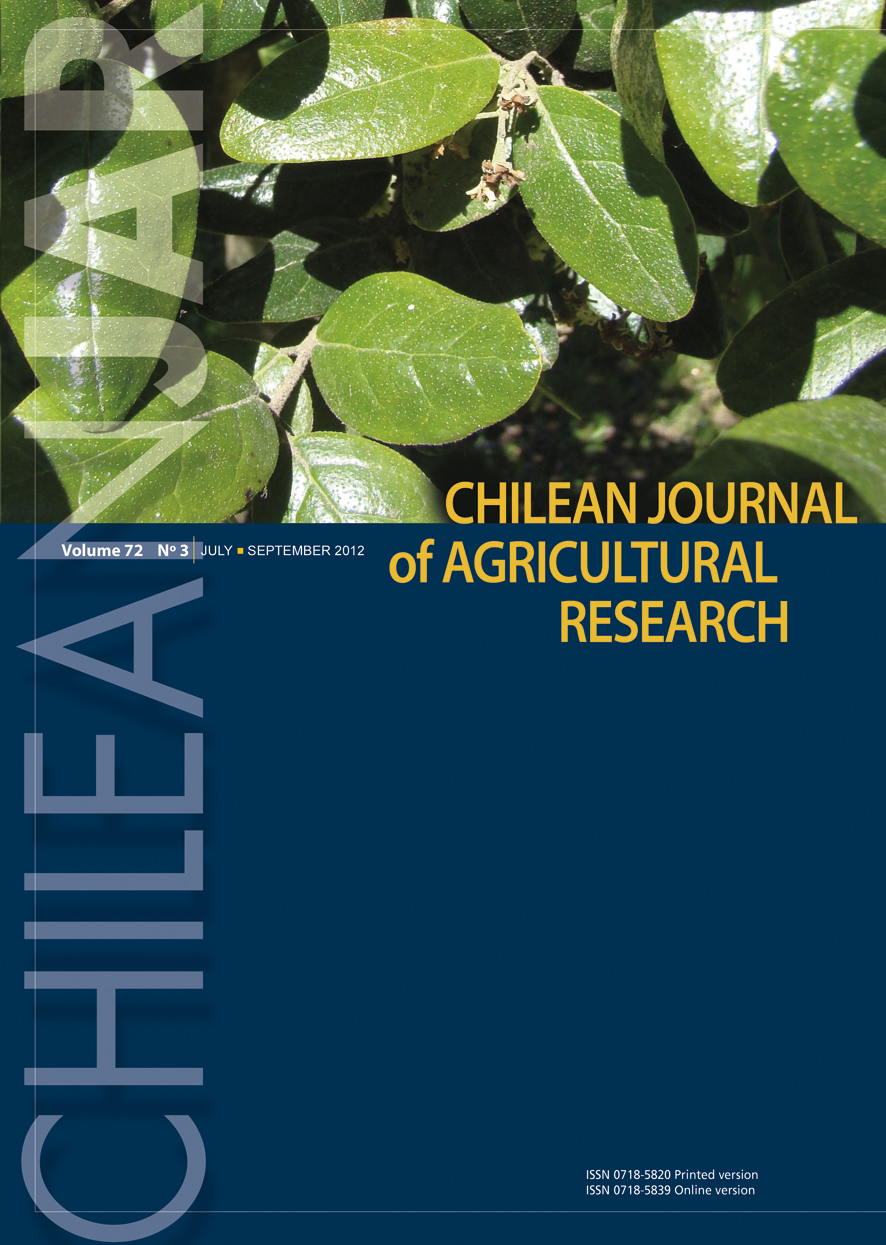
|
Chilean Journal of Agricultural Research
Instituto de Investigaciones Agropecuarias, INIA
ISSN: 0718-5820
EISSN: 0718-5820
Vol. 70, No. 3, 2010, pp. 498-502
|
 Bioline Code: cj10054
Bioline Code: cj10054
Full paper language: English
Document type: Research Article
Document available free of charge
|
|
|
Chilean Journal of Agricultural Research, Vol. 70, No. 3, 2010, pp. 498-502
| es |
Evaluación de boquillas antideriva en aplicaciones de agroquímicos en huertos frutales.
Behmer, Sergio; Prinzio, Alcides Di.; Striebeck, Guillermina & Magdalena, Jorge
Resumen
La producción frutícola exige varios tratamientos fitosanitarios anuales, cuya eficiencia se ve afectada por la deriva. Esta situación se agrava por la alta frecuencia de vientos y por la existencia de una importante población rural. El objetivo del trabajo fue evaluar la distribución en el árbol y cuantificar las pérdidas de producto en aplicaciones en huertos frutales. Se aplicó un trazador fluorimétrico utilizando un pulverizador hidroneumático en dos versiones: A) con boquillas de cono con inducción de aire, y B) con boquillas de cono estándar. Para evaluar la deriva se colocaron limpiadores de pipas en columnas ubicadas detrás de la fila adyacente a la tratada. Las pérdidas debajo del árbol se recolectaron en placas Petri ubicadas debajo de la fila tratada. Para evaluar la distribución se recolectaron hojas de la copa del árbol. La concentración de los depósitos se determinó mediante una técnica fluorimétrica y la superficie de las hojas mediante un medidor de área foliar óptico. Los resultados indican que ambas boquillas producen igual cantidad de depósitos en la copa del árbol, con menor cantidad en su parte superior. Las boquillas de inducción de aire presentaron una deriva 75% inferior a la deriva de las boquillas estándar; mientras que debajo del árbol sus pérdidas fueron 50% mayores. Se concluye que la utilización de boquillas antideriva en huertos frutales es una alternativa para mitigar la contaminación del ambiente.
Palabras-clave
fruticultura, pulverizaciones, deriva, boquillas con inducción de aire.
|
| |
| en |
Evaluation of low-drift nozzles in agrochemical applications in orchards
Behmer, Sergio; Prinzio, Alcides Di.; Striebeck, Guillermina & Magdalena, Jorge
Abstract
Fruit production demands several phytosanitary treatments per year. The efficiency of these treatments is affected by product loss because of drift, a situation that is aggravated by frequent high winds and the presence of a substantial rural population. The objective of this study was to evaluate the distribution and to quantify product losses in fruit orchard applications. Fluorescent tracers with air-blast sprayers were applied, using air-induction hollow cone nozzles, compared to conventional hollow cone nozzles. To evaluate drift, pipes cleaner were placed on columns behind the adjacent row to the treated one, and for the losses under the tree, Petri dishes were located below the treated row; for the distribution in the tree, leaves were collected from the canopy. The deposits were quantified with a fluorimeter, and the surface of the leaves with an area optical meter. Both nozzles produced equal quantity of deposits in the canopy with a minor quantity in the top part. The low drift sprinklers obtained 75% less drift than the standard nozzles; however, the losses under the tree were 50% higher. To conclude, the utilization of low drift nozzles in fruit orchards is an alternative to mitigate pollution of the environment.
Keywords
orchards, sprayers, drift, air-induction nozzles
|
| |
© Copyright 2010 Chilean Journal of Agricultural Research.
Alternative site location: http://www.inia.cl
|
|
